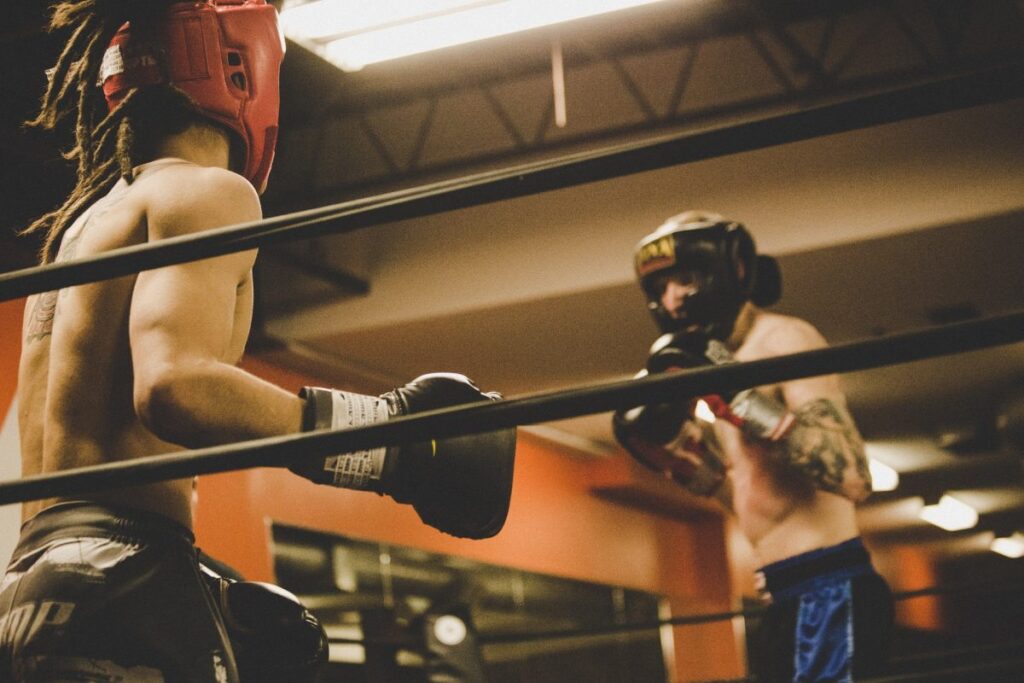
In the world of boxing, southpaw refers to left-handed fighters who use a unique fighting style to challenge their opponents.
To many boxing fans and fighters, southpaw fighters are known for their unpredictable movements and techniques, often making them a nuisance to regular orthodox fighters.
However, southpaws have unique weaknesses that are extremely important to understand when fighting them.
In this section, we’ll explore the basic characteristics of southpaws and their advantages in boxing, while explaining how to identify and counter their weaknesses.
目次
- 1 What is a southpaw? Understand from the basics
- 2 Common Weaknesses of Southpaw Warriors
- 3 Advice for boxers who are not good at southpaw
- 4 Practice routine to beat southpaw warriors
- 5 Examples of successful southpaw strategies
- 6 Southpaw boxing fighters: A summary of unknown weaknesses and countermeasures guide
What is a southpaw? Understand from the basics
The term southpaw is a term often heard in boxing and other martial arts, and generally refers to a left-handed fighter.
In contrast to normal right-handed boxers, or orthodox style fighters, southpaw fighters primarily use their left hand and are characterized by a different fighting style and standing position.
This stance can be very difficult for your opponent to deal with.
What are the characteristics of southpaw warriors?
The most notable characteristic of southpaw athletes is their unique stance. Southpaws have their right foot in front and use their left hand as a swipe.
This arrangement makes their attacks different from the patterns that orthodox players are accustomed to, creating movements that are difficult to predict.
Southpaw players also have the advantage of being able to easily take advantageous positions on defense, making it easier to dodge the opponent’s attacks.
Advantages of southpaw in boxing
The biggest advantage that southpaw athletes have is the strategic advantage their non-traditional stance gives them when playing against orthodox athletes.
Many orthodox athletes have little experience playing against southpaws, which makes it difficult for them to adapt to the attacks and movements unique to southpaws.
In particular, southpaw players’ left straights and left hooks are often very difficult attacks for orthodox players to deal with.
Additionally, southpaw players tend to take advantageous defensive positions, allowing them to effectively avoid attacks from their opponents.
The southpaw style allows for a fighting style that is difficult for opponents to predict and difficult to deal with.
As a result, southpaw fighters often use unique tactics and techniques to advance their matches to their advantage, enriching the strategic diversity of boxing.

Common Weaknesses of Southpaw Warriors
While southpaw athletes have many advantages, there are certain weaknesses.
Understanding these weaknesses and developing a strategy is crucial for athletes competing against southpaws.
Analysis of points that are easy to type in
- Straight Right : Southpaw players are more likely to receive a straight right than a right-handed player. This is because in the southpaw stance, the left side of the athlete is more likely to be open to the opponent, making it easier for a straight right to aim directly at the face or body.
- Movement to the right side : Southpaw players are vulnerable to hooks and uppercuts launched by their opponent moving to the right side. This is because the southpaw’s defensive structure makes it difficult to block attacks from the right side.
Common mistakes when dealing with southpaws
- Excessive use of the right hand : While it is true that right-handed attacks are effective against southpaws, relying too much on the right hand alone is risky. It is important to have variety in your attacks, as heavy use of your right hand makes you more susceptible to counter attacks and makes it easier to lose your balance.
- Misperception of distance : The distance with a southpaw player is different from that with an orthodox player. If you misjudge the distance to a southpaw player, it will be difficult to launch an effective attack, and you will be more likely to receive an effective attack. It is important to accurately understand your opponent’s attack range and fight at appropriate distances.
Developing an effective strategy against southpaw fighters requires understanding these common weaknesses and mistakes, and training and preparing accordingly.
By gaining experience against southpaw players, you will be able to find ways to exploit these weaknesses to your advantage in the match.

Advice for boxers who are not good at southpaw
Fighting against southpaw fighters is generally challenging for orthodox style boxers.
However, with proper strategy and practice, it is possible to overcome your fears about southpaw athletes and gain an edge in your competition.
Basics of strategy against southpaws
- Lateral Footwork : By placing your front foot on the outside of the southpaw’s front foot, you create an effective angle of attack and remove yourself from your opponent’s line of attack. This positioning makes it easier to hit right straights and right hooks.
- Use of the jab : Against southpaw players, use the jab aggressively, controlling distance and looking for opportunities to attack. A jab can disrupt a southpaw’s rhythm and set him up for an attack.
Techniques and practice methods that are useful in actual combat
- Mastering the right straight : Against southpaws, the right straight is a very effective weapon. In order to be able to hit this punch accurately and powerfully, you need to practice with both speed and power. When hitting the mitt or hitting the bag, focus on practicing the right straight.
- Practice with a southpaw sparring partner : Regular practice with a southpaw-style sparring partner is essential in order to familiarize yourself with southpaw tactics in a way that approximates real combat. By sparring with different types of southpaw players, you will be able to use a variety of tactics.
This advice for boxers who don’t like southpaws will help you improve your confidence and technique when fighting southpaws, from the basics of countermeasures to specific training methods.
Through continuous practice and strategy adjustments, you can improve your ability to deal with southpaw players and increase your success in competition.

Practice routine to beat southpaw warriors
In order to compete against southpaw fighters, it is essential to have a specific practice routine and understand the importance of effective sparring tips, footwork, and positioning.
The following practice routines and tactics will help you prepare to take on southpaw athletes.
Tips for effective sparring
- Sparring with southpaw players : By actively sparring with southpaw players, you can get used to their unique movements and attack patterns. Learn realistic reaction speeds and appropriate countermeasures by sparring with southpaw athletes.
- Throwing curveballs : Southpaw players require a more varied approach than orthodox players typically do. Try different tactics and combinations during sparring to see which attacks work.
The importance of footwork and positioning
- Moving to the outside : When playing against southpaw players, it is important to position yourself on the outside of their front foot (right foot) to avoid their powerful left hand. This move limits the opponent’s attack range and makes it easier to hit your own right straight or right hook.
- Balanced Footwork : Effective footwork forms the basis of tactics against southpaw fighters. Focus on practicing footwork so you can maintain balance and change positions quickly when attacking or defending.
Mastering these practice routines and techniques to counter southpaw fighters will greatly improve your performance in matches.
Playing against southpaw athletes can be difficult, but with proper preparation and strategy, it is possible to overcome the challenge.

Examples of successful southpaw strategies
Fighting a southpaw fighter is a big challenge for many boxers, but with the right strategy and preparation, success is possible.
Here, we will introduce historic matches against southpaws and examples of successful countermeasures against southpaws seen in modern boxing.
A historic match against southpaw
- Manny Pacquiao vs. Juan Manuel Marquez : Pacquiao is known as a strong southpaw fighter, and he showed off his speed and power against Marquez. However, Marquez used careful strategy and calculated counters to counter Pacquiao, and the two engaged in a fierce battle over several rounds. This series is remembered as emblematic of the importance of fighting southpaws.
- Floyd Mayweather Jr. vs. Zab Judah : Mayweather showed off some impressive southpaw tactics in his fight against Judah. Mayweather used his excellent footwork and defensive skills to fend off Judah’s attacks and rack up points with precision counters to earn the victory.
Measures against southpaws in the modern boxing world
- Technical Preparation : Modern boxers use more technical preparation to prepare for fights against southpaw fighters. It is common to study southpaw movements and attack patterns and develop strategies through video analysis and sparring.
- The importance of adjustments : Modern training also emphasizes the ability to flexibly change strategies during a match. If your initial approach against a southpaw player doesn’t work, you’ll need to quickly change tactics and try different angles and methods of attack.
His success against southpaw fighters shows how important proper preparation, precise strategy, and flexibility during the fight are.
Learning from these examples will give boxers insights that will help them gain an advantage in matches against southpaw fighters.

Southpaw boxing fighters: A summary of unknown weaknesses and countermeasures guide
The southpaw style requires unique strategies and techniques in boxing.
Throughout this article, we have detailed the basic characteristics of southpaw athletes, their benefits and common weaknesses, as well as practice routines and strategies to face southpaws.
By understanding how to fight southpaw athletes and taking appropriate measures, you can effectively respond to their unique tactics.
Understanding southpaw fighters’ weaknesses and training accordingly is essential to gaining an advantage in matches against southpaw fighters.
You’ll also learn effective sparring tips and the importance of footwork and positioning, improving your practical skills to overcome the challenges of being a southpaw fighter.
Furthermore, by studying historical examples of matches against southpaws and ways to counter southpaws in the modern boxing world, you can deepen your understanding of strategies and apply them to your own tactics.
When competing against southpaw athletes, it is important to make full use of these knowledge and techniques to compete.
Finally, strategies for dealing with southpaw fighters are not something that can be learned overnight.
The key to success is building confidence and skill in facing southpaw fighters through continuous training and match experience.
Fighting a southpaw fighter is a big challenge for a boxer, but with the right preparation and strategy, it is possible to overcome the challenge.





